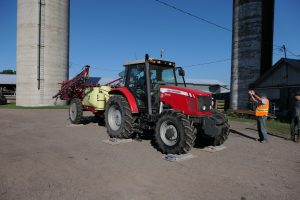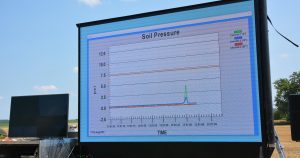Written by: Emily Potter, Northeastern Ontario Regional Communication Coordinator

Photo courtesy of OSCIA. Weigh clinic at Elgin County SCIA event, Fall 2021
As we wrap up 2021, we are presented with the opportunity to reflect on the last year. OSCIA’s Mobile Soil Technology Suite (MSTS) launched this past summer and attended several small events, including two weigh clinics in Elgin County. These clinics provided the opportunity for producers to weigh their farming equipment, followed by practical discussions on how their tires can be best managed to promote soil health and address soil compaction.
When discussing the lessons learned on soil compaction, we can recall the 2021 OSCIA Annual General Meeting presentation that featured a breakdown of previous compaction day events. Warren Schneckenburger, President-elect of OSCIA hailing from Eastern Valley, and Alex Barrie, Soil Management Engineer with OMAFRA, came together to hold an open discussion with participants about lessons learned from their data collection of the successful demonstrations that took place in the summer of 2019.
Schneckenburger reflected on the Dundas County compaction day event that took place in August 2019. Over 40 volunteers worked together for a full week to prepare for the event. This included organizing over 48 pieces of equipment with multiple configurations. For each piece of equipment, they weighed each individual wheel and axel to determine weight load at each point. All equipment had a weighted load to try and get the maximum impact during the tests.
“Tire pressures on equipment fluctuate wildly wheel to wheel, let alone axel to axel,” said Schneckenburger when talking about the things they learned when weighing equipment in preparation for the event. Equipment with tracks posed another challenge, with multiple axel loads within each track, needing weights for each axel.

Photo courtesy of OSCIA. Set up for Compaction Day event, Dundas County.
On-site specialists determined what the maximum weight carrying capacity for each tire was, and what air pressure it should be set at.
Electronic pressure sensors were also buried in the soil, stacked at various depths (six inches, 12 inches, and 20 inches). Through a series of tests involving driving different pieces of equipment with different configurations over the sensors, the group was able to measure the rate of compaction at each depth within the soil. Two and a half days were spent researching and testing the different pieces of equipment and tire pressures.

Photo courtesy of OSCIA. Wheat Pete (Peter Johnson) and Warren Schneckenburger presenting during Dundas County Compaction Day event.
Then came the live demonstration. Over 300 people attended the compaction day in Dundas County. Specialists talked about various topics, such as soil health and cover crops. They also set up a large screen to display the pressure graphs in real-time as volunteers drove different pieces of equipment over the pressure sensors. They also demonstrated Central Tire Inflation Systems in real-time to demonstrate optimizing tire pressures for the road and for the field.
Similar events were held in Arthur in 2018 and Shedden in 2019. All data on various equipment configurations were collected and compiled into one large file. Barrie explained that each section will have information such as where the compaction event was held and when, what the equipment set-up was, photos of the equipment, diagrams of the test configurations and a number of plots showing the pressure data collected. Next steps include making this research available on the OMAFRA website. The goal is to have a fully searchable database of tested equipment and compaction data for producers to easily access. Keep posted!